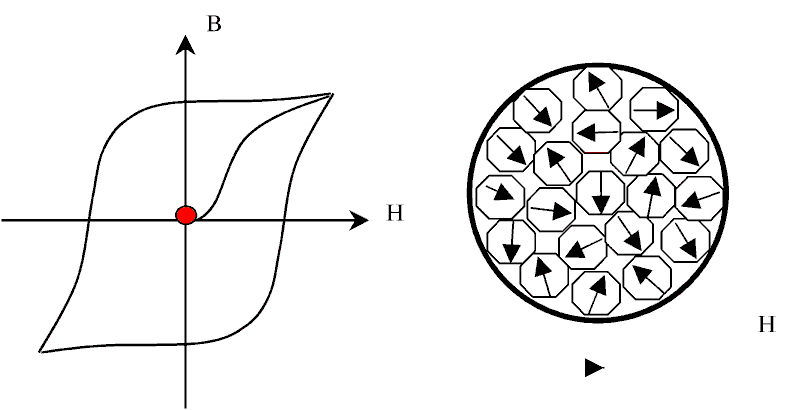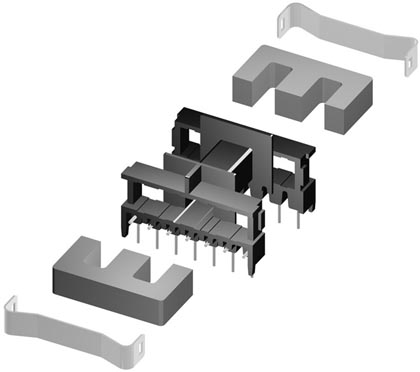Abstract by topic of master's work
Introduction ⇑
Magnetic materials, both metals, and dielectrics are widely used in modern technics: in power engineering, communication systems, computing equipments. The especial place is occupied with ferrite which thanks to the big electric resistance can be used on very high frequencies. Magnetic cores and antennas in radio- and television equipment, magnetic tapes for a tape recording, the different devices of a microwave range remembering and logic units in the computer - here the short list of the uses of magnetic dielectrics without which it is difficult to fancy many areas of modern technics[1]. In the industry ferrite began to be used about half a century back; they have been developed as alternative to metal magnets[2]. As provide decrease in an energy loss on reversal magnetisation, decrease of eddy currents and the electromagnetic losses connected with them.
Ferrite - magnetic semiconductors with structure of the ionic crystals, formed on the basis of a chemical compound oxide gland Fe2O3 oxides other metals[3]. There is an assemblage of elements which at introduction in composition change processes, caking and recrtstallization. Ferrite, per se, are typical joints of variable composition which generally it is possible to express formula AB2O4±γ where and in any elements. Especially big scientific interest is represented by magnetic-soft ferrite.
Manganese-zinc ferrite are used instead of applied earlier nickel-zinc as differ more the best electromagnetic properties and frequency characteristics. Comparison of magnetic properties of these ferrite with equal initial magnetic permeability shows that in the field of frequencies to 2 MHz manganese-zinc ferrite have essentially smaller relative tangent of angle of losses that speaks very small losses in them on a hysteresis[2]. Important advantage high-permeability manganese-zinc of ferrite is the raised induction of saturation and higher Curie temperature[4].

Fig.1 – Changing the orientation of domains in the ferrite
Unconditionally, properties of ferrite essentially depend on the maintenance of a part basic components, but thus the essential contribution is brought in also by conditions of their reception. Observing ferrite as phases of variable composition should be noted that formation of structurally sensitive properties to a great extent depends on the maintenance in them O2, forming a defective condition[6]. On oxygen it is possible to provide ferrite composition with change of conditions of roasting, proceeding from relationship Р(O2)-T.
Survey of researches on a theme in Ukraine ⇑
The literature analysis, and also search on the Internet showed that researches similar to a theme were spent in Ukraine in the second half of 20 centuries. In the nineties rates of research of ferrite decreased[5]. The same that were spent, studying of agency of composition on properties manganese-zinc of ferrite in the conditions of caking in vacuum furnaces with maintenance of an isoconcentration regime on oxygen did not touch. Namely it is the most actual for modern producers of ferrite in Ukraine.
It is connected with complexity of maintenance of an equilibrum regime of caking in furnaces, and also with escalating demands to a quality of product. For today "user" requests qualitative martempering of electrophysical properties ferrite.
Survey of researches on a theme in the world ⇑
Researches of ferrite in the world, after peak of the sixtieth - the seventieth years of the last century, considerably were devided out and renewed in the beginning of it[7]. Unfortunately, the increase in quantity of researches in the field of magnetic dielectrics on a basis oxide gland is provided with only separate firms specialising on given products.
Today's leaders in the CIS countries are the foreign companies[8]. By 2008 in the Post-Soviet countries the leading position was occupied with power ferrite materials firms Epcos (Germany), which volume of consumption, the domestic industry, considerably exceeds volume of deliveries of all other together taken foreign producers.
Also products of such firms, as Ferroxcube (Netherlands), Cosmo (India), Samwha (Korea), Yeng-Tat (Taiwan), Acme (Taiwan) is popular. The only thing, for today, the Ukrainian factory capable to make it a concurence in the near abroad market is "Ferrokeram" (Belaja Cerkov, the Kiev region).
The Ukrainian ferrite factories continue to occupy an essential niche in the domestic market, however gradually give in to foreign manufacturers. It is necessary to note that material М2500НМС1 released by factory "Ferrokeram", does not concede on the majority of the characteristics to material N87 Epcosо[8]. But products from it considerably lose in the price because of the high cost price connected with small, in comparison with foreign competitors, volumes of output. So the total volume of output of all ferrite materials in territory of the CIS on the tonnage makes less than 3 % from firm Epcos volume of output.
As a result even traditional types of cores which in the core formed the domestic market, are gradually expeled by their import analogues. Only in the last two days in the market there were, for example, full analogues of domestic standard sizes Ш4×4, Ш4×8, Ш6×6, Ш10×10.

Fig.2 – Ш-type ferrites

Fig.3 – Ferrite rings

Fig.4 – The crystal structure of spinel ferrites: a - schematic representation of the unit cell of spinel structure, which is divided into 8 octants b-arrangement of the ions in the adjacent octant cell, white circles - anions О2-, forming the skeleton of the lattice, black - cations in the octahedral and tetrahedral positions, in-cation in the tetrahedral d-cation in an octahedral environment.
The work purpose ⇑
The work purpose is research of agency of composition on the basic components manganese-zinc of ferrite of a brand 2500НМС-2 and roasting conditions on formation of structurally-sensitive properties.
Experimentally-methodical part ⇑
Work assumes reception of ferrite materials of a brand 2500НМС-2. Material sampling 2500НМС-2, is caused by scale manufacture and the big demand of this ferrite[9]. Reception of investigated samples was carried out on ceramic production engineering by a method interactings and carbonates of the metals which are entering into a formula.
The various maintenance оксида gland was put at a stage a charge at constant relationship МnО/ZnО = 2,675. The concentration interval on Fе2O3 made 48-56,5 pier. % through 0,5 pier. % between points of conducting of experiments. Roasting of ferrite samples spent in the vacuum plant on equilibrum isoconcentrates γ=10*10-3 and γ=1*10-3 Р(O2)-T-phase diagramme and on the regimes modelling standard vacuum programs ох¬лаждения V and IX.
At maintenance change oxide gland in composition is installed that its increase leads to the effects observed at decrease oxygen. Oxide gland in manganese-zinc ferrite at stechiometry relationship Fe/(Zn+Mn)=2:1, without taking into account cations distributions on sublattices A and B it is possible to express process of dissolution of excess a following equation.

from which it is visible that change of the maintenance of oxygen in ferrite is connected both with direct oxygen γ, and with the maintenance superfluous oxide ferum ν. Both parametres - γ and ν - enter in stechiometry an index at oxigen. Increment of the maintenance superfluous oxide gland ν to be compensated decrease in parametre oxygen nonstechiometry γ. The Physical and chemical nature of this analogy is connected with character of agency of magnitudes γ and ν on the magnetite maintenance in a solid solution[10]. The magnetite maintenance increases with increase maintenances oxide gland ν and extent decrease γ. From this it follows that increase agency oxide gland to lead to the effects analogous at decrease γ.
Conclutions ⇑
- It is shown that treatment process makes essential impact on formation of structurally-sensitive properties.
- It is installed that electromagnetic properties depend as from oxygen nonstechiometry, forming deficiency of a material, and on the maintenance oxide gland in composition.
- Results of researches can be used for optimisation of composition of ferrite on acting manufactures.
References ⇑
- Поляков А.А. Технология керамических радиоэлектронных материалов – М.: Радио и связь, 1989г. – 200с.: ил.
- Левин Б.Е., Третьяков Ю.Д., Летюк Л.М. Физико-химические основы получения, свойства и применение ферритов. - М.: Металлургия, 1979. - 470с.
- Третьяков Ю.Д., Олейников Н.Н., Граник В.А. Физико-химические основы термообработки ферритов, - Издательство московского университета, 1973г. - 205с.
- Третьяков Ю.Д., Метлин Ю.Г. Керамика – материал будущего. – М.: Металлургия, 1987г.
- Прилипко Ю. С. Функциональная керамика. Оптимизация технологии: Монография. - Донецк: Норд-Пресс, 2007. - 492 с.
- Шольц Н.Н., Пискарев К.А. Ферриты для радиочастот, - М.: Энергия, 1966г. – 260с.
- Свиридов В.В., Адамович Т.И., Кунцевич Н.И., Лобанок А.Д. Особенности образования феррита цинка в системе совместно осажденных гидроксидов Zn(OH)2-Fe(OH)3 – Физические свойства ферритов. Мн.: Наука и техника, 1967 – 395с.
- Физико-химические основы получения твердофазных материалов электронной техники [Электронный ресурс]. - Режим доступа:URL
- Новосадова Е.Б., Дригибка Я.Г., Пашкова Е.В. и др. Поли- и монокFigталлические марганец-цинковые ферритовые материалы – Марганецсодержащие ферриты: Синтез и физико-химические свойства. М.: Наука, 1986 – 180с.
- Свиридов В.В., Белозерский Г.Н., Байков М.В. и др. Исследование процесса образования ферритов из совместно осажденных гидроксидов методом ЯГР – Кинетика и катализ. 1974 – 960с.
|